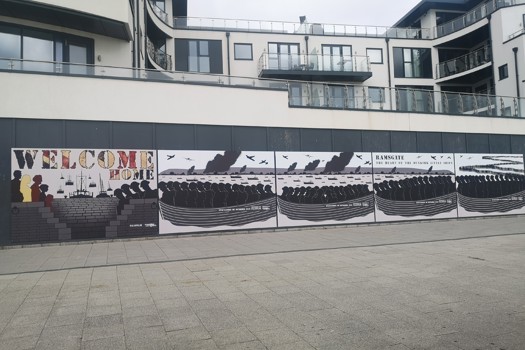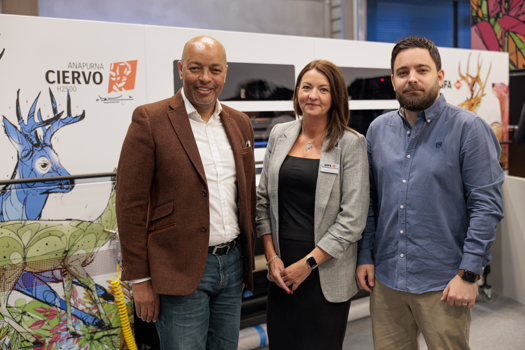What does it do?
It’s a Czech-built B2-plus format digital spot varnishing machine, using inkjet technology to apply UV-cured clear coatings. Friedheim is the UK agent. The price is significantly below its main competitors, but apparently so is the resolution, although this may not be a big issue. It is sheetfed with camera-based automatic registration to pre-printed sheets. By using multiple passes it can build up raised or textured areas similar to embossing. It is intended for short-run and variable varnishing work for both digital and analogue print.
When was it launched?
Its first UK showing was at Ipex in March. However, the original ‘concept’ prototype Spotmatic 52 was launched at Drupa 2008. The production model is a complete redesign and the processing module has also been redesigned to achieve perfect registration. There is also a B1-format Spotmatic 76 model, which offers similar capabilities but with older, slightly slower technology.
How does it work?
The input files are standard PDFs or TIFFs, created in layout programs such as InDesign, with a layer to denote the varnish image.
The Spotmatic front-end picks up the varnish layer and sends it to the printer. This is a networked PC that can receive files from any other source.
The I2Ir optical registration system uses cameras to detect any pre-set marks on the print. This lets it correct for mispositioning or drift of the print image on the sheet, so the varnish layer is always in registration.
Multiple passes of the sheet can be made (up to eight), building up the image to a maximum of between 100 and 200 microns depending on the surface energy of the substrate. Heights and effects can be varied within the same image to create textures or to vary between gloss and matt. These are defined in the artwork by using a greyscale as a height map.
If the whole paper stack is re-loaded and sent through again, effects as high as 1mm are possible.
The clear varnish is cured by mercury vapour lamps to keep up with the speed of 20 sheets per minute. If multiple passes are needed to build up a raised image, then the sheet is first cured and then the vacuum belt reverses and takes it through again for the next pass.
What’s the USP?
The Spotmatic faces established competition, in particular from Scodix and MGI, which have more expensive B2 digital UV varnishers with similar 3D capabilities. According to André Hilkens, manager of Komfi Europe in the Netherlands: “The build quality and registration of the machine is outstanding, thanks to the new paper feed and transport system. Also, to create outstanding multi-pass results we cure the varnish in between the separate passes. This process can be set up in the software to be fully automatic.”
How easy is it to use?
“The user interface is very clearly laid out and divided into different user levels,” says Hilkens. “Once the PDF or TIFF file is ready and sent to the machine it is as easy as operating a copier. The operator loads the paper and runs a test sheet through the machine. Once set up, the operator presses the start button and the machine does the rest, fully automatically. Cleaning of the machine at the end of the day only takes 10-15 minutes.”
What training and support is offered?
One week’s operator training at the factory is all that’s needed, says Hilkens. UK field support will be handled by Friedheim.
What’s the sales target?
According to Hilkens: “Our sales target is to sell 10 units a year worldwide.” At present there is one user of the first generation Spotmatic 52 in the Czech Republic. This user was unavailable to provide comment.
SPECIFICATIONS
Speed 1,200sph (single pass)
Max sheet size 540x800mm
Min sheet size 300x240mm
Substrate weight range 115-600gsm
Max coating thickness 100 to 200 microns (8 passes), higher with re-loading
Resolution 360dpi
Footprint 4.7x1.4m
Price €200,000 (around £160,000)
Contact Friedheim 01442 206100 www.friedheim.co.uk
ALTERNATIVES
MGI JetVarnish 3D
The second-generation JetVarnish was announced at Drupa 2012. It was faster and introduced the ability to build up raised and textured images similar to Scodix, and process longer sheets. There is a twin camera-based registration system. There are coatings for 2D (flat) and 3D finishes, with twin feed tanks. Last year MGI introduced iFoil, an add-on inline system that can apply metallic foil to the varnish before curing, simulating foil blocking but with variable data potential.
Speed 3,000sph (2D)
Max sheet size 520x1,050mm
Min sheet size 210x300mm
Max clear print area 515x1,045mm
Substrate weight range 135-600gsm
Max coating thickness 100 microns (200 microns with 2nd head Twin option)
Resolution 1,200dpi
Footprint 7.7x2.2m
Price Around £250,000
Contact MGI Technology UK 01442 446446 www.mgitechnology.co.uk
Scodix Ultra
Scodix was the first to introduce a single-pass inkjet super-clear varnish process that can build up raised and textured images (it calls this Sense). The third-generation Ultra model, announced at Print 2013, is almost twice as fast as the previous S75, which is still available at around £200,000. Ultra has twin trays for faster feeding and camera recognition for registration to printed images. Scodix’s optional Rainbow peripheral can add glitter to the varnish. A foil blocking effect can be simulated on special laminate.
Max speed 1,250sph (raised imaging)
Max sheet size 545x788mm
Min sheet size 297x420mm
Max clear print area 505x764mm
Substrate weight range 135-675gsm
Max coating thickness 250 microns
Resolution 2,540x450dpi
Footprint 6.3x1.8m
Price From £320,000
Contact Conversion 07584 055863 www.conversion-uk.com










